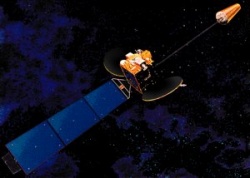If you wish to contribute or participate in the discussions about articles you are invited to contact the Editor
MSAS Space Segment
| MSAS | |
|---|---|
| Title | MSAS Space Segment |
| Author(s) | GMV. |
| Level | Basic |
| Year of Publication | 2011 |
The Multi-functional Satellite Augmentation System (MSAS) is the Japanese SBAS System: a GPS Augmentation system with the goal of improving its accuracy, integrity, and availability, and that uses the Multifunctional Transport Satellites (MTSAT). Tests had been accomplished successfully, and MSAS for aviation use was commissioned on September 27, 2007.[1]
MSAS receives GPS signal at the Ground Monitor Stations and the Monitor & Ranging Stations, checks operational status of GPS, analyze GPS error and ionospheric delay, and then broadcasts augmentation information through MTSAT (Multi-functional Transport Satellite) from the Master Control Stations. Those satellites, MTSAT, broadcast the correction messages back to Earth, where MSAS-enabled GPS receivers use the corrections while computing their positions to improve accuracy.
MSAS Space Segment
The space segment consists of two geosynchronous communication satellites (GEO): the Multifunctional Transport Satellites (MTSAT), with navigation payloads which broadcast the correction messages generated by the Master Stations for reception by the User segment. These two satellites are not only devoted to navigation, but also to meteorological/weather purposes.
They are geostationary satellites owned and operated by the Japanese Ministry of Land, Infrastructure and Transport and the Japan Meteorological Agency (JMA), and provide coverage for the hemisphere centred on 140° East; this includes Japan and Australia who are the principal users of the satellite imagery that MTSAT provides. They replace the GMS-5 satellite, also known as Himawari 5. They can provide imagery in five wavelength bands — visible and four infrared, including the water vapour channel. The visible light camera has a resolution of 1 km; the infrared cameras have 4 km (resolution is lower away from the equator at 140° East). The spacecraft have a planned lifespan of five years. MTSAT-1 and 1R were built by Space Systems/Loral. MTSAT-2 was built by Mitsubishi. [2]
The launch of MTSAT-1, on a Japanese H-II rocket, failed on November 15, 1999 and the spacecraft was destroyed. GMS-5, the satellite MTSAT-1 was intended to replace, was decommissioned on April 1, 2003 leaving Japan without weather satellite imagery. To fill in the void, The United States National Oceanic and Atmospheric Administration (NOAA) loaned the GOES-9 satellite to the JMA and repositioned it over 145° East on May 22, 2003.
MTSAT-1R (also known as Himawari 6) was successfully launched on a H-IIA on February 26, 2005 and became partially operational on June 28, 2005 — the aviation payload was not functional as two MTSATs are required for air traffic control. GOES-9 was decommissioned when MTSAT-1R came online in June 2005.
MTSAT-2 (also known as Himawari 7) successfully launched on February 18, 2006 and is positioned at 145° East. The weather functions of MTSAT-2 were put into hibernation until the end of MTSAT-1R’s life (5 years from launch). The transportation and communication functions of MTSAT-2 will be utilized prior to that time.
Both satellites, MTSAT-1R and MTSAT-2, are controlled by Kobe MCS station and Hitachiota MCS, respectively.
| Satellite Name & Details | NMEA / PRN | Location |
|---|---|---|
| MTSAT-1R | NMEA #42 / PRN #129 | 140°E |
| MTSAT-2 | NMEA #50 / PRN #137 | 145°E |

